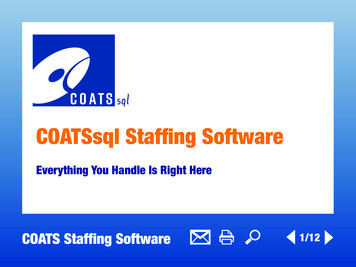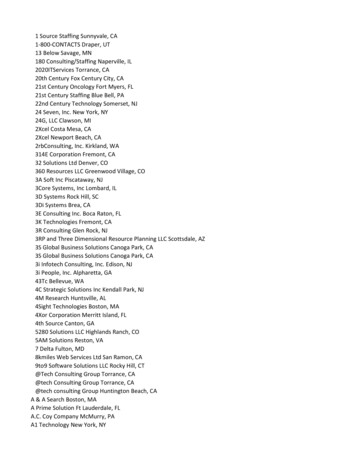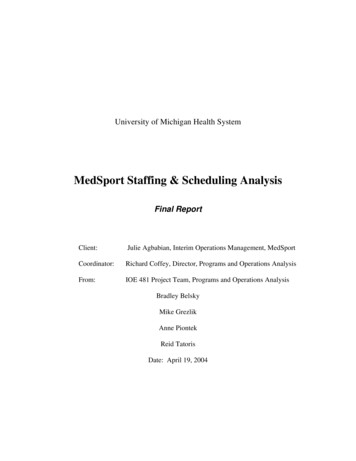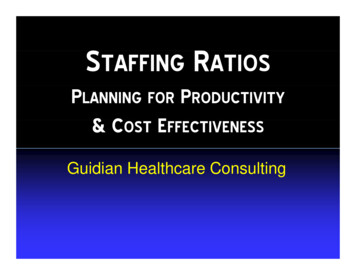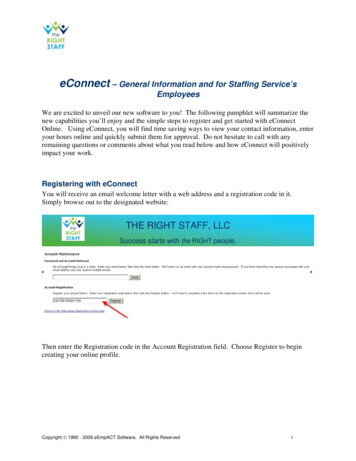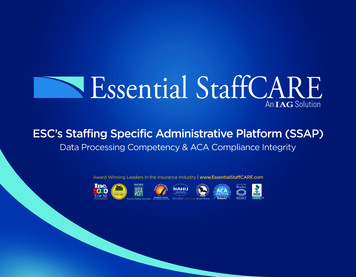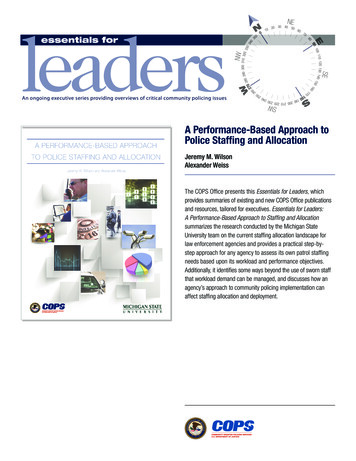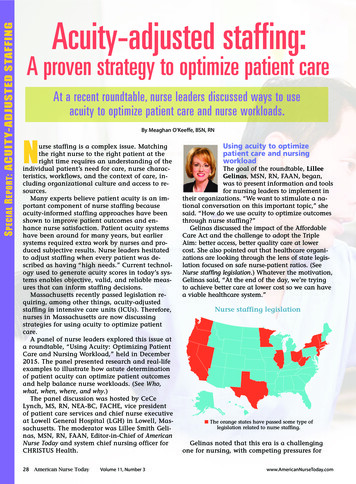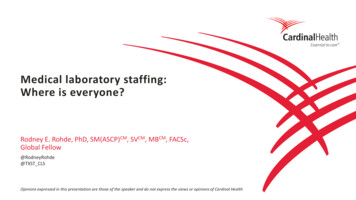
Transcription
Medical laboratory staffing:Where is everyone?Rodney E. Rohde, PhD, SM(ASCP)CM, SVCM, MBCM, FACSc,Global Fellow@RodneyRohde@TXST CLSOpinions expressed in this presentation are those of the speaker and do not express the views or opinions of Cardinal Health
Webinar SummaryThe medical (clinical) laboratory has long been dealing with employment staffingshortages due to a number of factors. With the ongoing COVID-19 pandemic, thelaboratory staffing issue has been revealed to reaching a critical and dangerous breakingpoint due to several already known, but now amplified challenges. This webinar willexplain several factors (retirements, burnout, free agency travelers, etc.) at theintersection of laboratory staffing and quality patient healthcare.2 2021 Cardinal Health. All Rights Reserved.
Learning Objectives31.Explain the challenges around recruitment and retention in the laboratory revealed in ASCP’s Wageand Vacancy surveys.2.Discuss the evolution of medical laboratory staffing over the past several decades.3.Describe how factors such as retirement, burnout, traveling laboratory professionals (free agency)and visibility play a role in staffing shortages.4.Discuss the challenges of education, visibility and salary on the future of our profession as it relatesto staffing. 2021 Cardinal Health. All Rights Reserved.
Context:According to the Bureau of Labor Statistics,approximately 4,900 students graduate from MLS andMLT programs in the U.S. every year. But there are9,000 job openings. So, what’s behind the 46% vacancyrate? And what can we do as laboratory professionals toaddress these significant staffing shortages?4 2021 Cardinal Health. All Rights Reserved.
Starting Background – ASCP Workforce Report, 2018 Participation:‒1,195 respondents (individuals who have hiring responsibilities) representing34,059 employees Conducted through collaboration between ASCP’s Institute of Science,Technology, & Policy in Washington, DC, the Evaluation, Measurement,and Assessment division and Board of Certification in Chicago, IL. Vacancy Survey Working Group, whose members work in the field oflaboratory medicine, reviewed the survey questions and critiqued the"COVID-19 Frontline Health Workers" by UN WomenAsia & the Pacific is licensed under CC BY-NC-ND 2.0report.Garcia E, Kundu I, Kelly M, Soles R. The American Society for Clinical Pathology's 2018 Vacancy Survey of Medical Laboratories inthe United States. Am J Clin Pathol. 2019 Jul 5;152(2):155-168. doi: 10.1093/ajcp/aqz046. PMID: 31135889.5 2021 Cardinal Health. All Rights Reserved.
2018 ASCP Vacancy Survey – Summary of Findings Across the nation, the overall vacancy rate was highest for phlebotomydepartment (13.20%) and lowest for point-of-care department (4.03%). Phlebotomy (13.59%) has the highest nonsupervisory vacancy rate in thenation while point-of-care (4.08%) has the lowest staff vacancy rate. The highest supervisor vacancy rate occurred in the phlebotomy department(7.57%) and the lowest supervisor vacancy rate occurred in the specimenprocessing department (2.29%). LIS/QA/PI department has the highest overall percentage (27.12%) ofemployees anticipated to retire in the next 5 years. Phlebotomy has thelowest rate of employees expected to retire in the next 5 years, at 9.63%.6 2021 Cardinal Health. All Rights Reserved."GCC Center for Workforce phlebotomy lab"by Germanna CC is licensed under CC BY 2.0
2018 ASCP Vacancy Survey - Summary of Findings Overall, survey results show that it takes between 0 to 6 months to fill positions in thedepartments surveyed. On average, hiring staff for most departments takes 3 to 6 months, while hiring supervisors take 3months to 1 year. The Central Northeast region reported the highest overall vacancy rate compared to other regions(11.10%); the Central Northwest had the lowest vacancy rate (5.62%).7 2021 Cardinal Health. All Rights Reserved.
2018 vs 2016 ASCP Overall Vacancy Rates8 2021 Cardinal Health. All Rights Reserved.
2018 vs 2016 ASCP Overall Vacancy Rates Results of the 2018 vacancy survey shows increased vacancy rates for laboratory positions (except forchemistry/toxicology, flow cytometry, LIS/QA/PI, point of care and specimen processing) across alldepartments surveyed compared to 2016. #1 laboratory workforce concern this year 21.10% of respondents reported the need for bettersalaries for laboratory personnel and increased effort in heightening the profile of the laboratoryprofession in the medical field. #2 top concern qualified laboratory professionals (18.35%). Respondents indicate that there is a greatneed for more graduates from accredited laboratory training programs to fill the vacancies created byretirement. #3 concern education and training programs (9.17%). There is a crucial need to promote the field inhigh schools and colleges. They also mentioned the need for increased internship offerings forlaboratory training programs and training in molecular biology.9 2021 Cardinal Health. All Rights Reserved.
Vacancy Survey Overall Retirement Rates10 2021 Cardinal Health. All Rights Reserved.
ASCP Vacancy 2018 Report Summary Data from this survey show that vacancy rates are considerably higher in most ofthe departments compared to that in the 2016 report. For the first time since 2012, the retirement rates for most of the departmentssurveyed were at their lowest. Certification requirements continue to increase for most departments, suggestingthe hiring manager’s need for more qualified and certified laboratory personnel.11 2021 Cardinal Health. All Rights Reserved.
ASCP Vacancy 2018 Report Summary Results from the qualitative analyses suggest:‒ The need for more graduates from accredited laboratory training programs to fill the vacancies left byretirement.‒ A vigorous recruitment campaign should be put in place now to address future shortages.‒ The critical need to focus on retention of lab professionals currently working in the field.‒ Strategies on advocating for better salaries for laboratory personnel both in the local and nationallevel should be discussed.‒ The field should also concentrate on the multi-generational differences between laboratory personnelas it relates to retention.12 2021 Cardinal Health. All Rights Reserved.
“In the past 3 years, we have lost 34% ofour staff and only regained about 10%. It ismainly due to retirement for older techsand dissatisfaction with current practicefor new techs. Sign on bonuses and betterwages are drawing new techs away.”13 2021 Cardinal Health. All Rights Reserved.
2018 vs 2016 ASCP Overall Vacancy Rates For the first time since 2012, retirement rates (for those who anticipate retiring in the next five years) forlaboratory professionals are at its lowest across the majority of departments.‒[**My personal interaction in the current pandemic indicates that this may not be “holding,” as we are witnessing a significantnumber of retirements – 2020 ASCP Report is not currently published.] Retirement rates for both staff and supervisor have also declined, except for the anatomic pathology,cytogenetics, flow cytometry, and phlebotomy departments for staff, and cytology, flow cytometry, molecularpathology/diagnostics, and point-of-care departments for supervisors. Previous ASCP vacancy reports have suggested that the field will experience a loss of laboratory personnelwho have been in the field for a long period of time and have a vast amount of experience. Current datasuggests that this loss of personnel has already occurred.14 2021 Cardinal Health. All Rights Reserved.
15 2021 Cardinal Health. All Rights Reserved.
History of staffing – looking over 30 years Hospital-based programs versus academic programs Numbers of programs in different regions / states of the United States Licensed versus non-licensed states Certification"High Street City Community Hospital" by CindyFunk is licensed under CC BY 2.016 2021 Cardinal Health. All Rights Reserved.
History of staffing – looking over 30 years Revenue / reimbursement in healthcare Automation / technology‒ Still need “the brain / troubleshooter”"Money" by thejedi is licensed under CC BY-NC-ND 2.0‒ Informatics / computer science upgrades in our education 17Cost of programs / academic misunderstanding 2021 Cardinal Health. All Rights Reserved.
History of staffing factors – looking over 30 years Awareness / Recognition‒ Upstream and downstream issues‒ What is in a name? Clinical placements / rotations‒ Consolidation of microbiology / blood bank is a national problem Salary – “Show me the money!”Texas State University – CLS Program‒ Visibility is key – DCLS / Diagnostic Management Teams / highly educated in general‒ More public-facing attention for the laboratory / “public pressure”18 2021 Cardinal Health. All Rights Reserved.
ASCP’s 2019 Wage Survey of Medical Laboratories19 2021 Cardinal Health. All Rights Reserved.
ASCP’s 2019 Wage Survey of Medical Laboratories20 2021 Cardinal Health. All Rights Reserved.
ASCP’s 2019 Wage Survey of Medical Laboratories21 2021 Cardinal Health. All Rights Reserved.
ASCP’s 2019 Wage Survey of Medical Laboratories22 2021 Cardinal Health. All Rights Reserved.
Comments from ASCP’s 2019 Wage Survey of MedicalLaboratories Participants Total comments received: 3,891 Addressed being underpaid/underappreciated especially compared to nursing and otherallied health professions Indicated that there are shortages due to hiring, retention, and staffing challenges Commented on feeling lack of appreciation from their peers and lack of recognition in thehealth care field in general, despite being highly qualified and being an important part ofpatient care Commented on low wages and lack of staff leading to early burnout in rural areas; thosebelonging to urban areas noted that their wages are not enough to meet the high cost ofliving23 2021 Cardinal Health. All Rights Reserved.
History of staffing factors – SARS-CoV-2 / COVID-19 The “COVID-19 Pandemic effect”‒ The National Testing strategyCDC - PHIL ID #23311‒ Too MUCH work versus NO work due to cancellation of non-critical surgery, procedures, etc.‒ Free agency MLS‒ High burnout due to massive COVID testing demands on top of regular workload “some fear of infection” / “caregiver issues”‒ Younger / newer professionals may be leaving field ASCP Survey / personal information shows that staffing appears to be coming back24 2021 Cardinal Health. All Rights Reserved.
History of staffing factors – SARS-CoV-2 / COVID-19 The Pandemic Spotlight can help:‒ International, national, state coverage by news, articles, and other media outlets‒ Increasing visibility of our college MLT / MLS / Specialists / DCLS programs leading to more majors inprograms Education / Academic impact‒ Faculty lines / tenure impact [travel, research, etc.]‒ Budgets‒ Prerequisite courses / major course loss of “class / lab time”25 2021 Cardinal Health. All Rights Reserved.
The Future – What are some of the biggest challenges Staffing!‒ Retirement of seasoned veterans / experts‒ Recruitment / retention‒ Mentoring towards administration / leadership Pipeline of future laboratory professionals"Trans-Alaska Oil Pipeline" by rickz is licensed under CCBY-NC-ND 2.0‒ Generational differences / health disparities / urban versus rural / diversity Education of future laboratory professionals‒ Lack of clinical placements / rotations‒ We are at crisis mode now in the United States26 2021 Cardinal Health. All Rights Reserved.
References and Resources Garcia E, Kundu I, Kelly M, Soles R, Mulder L, Talmon GA. The American Society for Clinical Pathology's Job Satisfaction, Well-Being, andBurnout Survey of Laboratory Professionals. Am J Clin Pathol. 2020 Mar 9;153(4):470-486. doi: 10.1093/ajcp/aqaa008. PMID: 32080719. Garcia E, Kundu I, Kelly M, Soles R. The American Society for Clinical Pathology's 2018 Vacancy Survey of Medical Laboratories in the UnitedStates. Am J Clin Pathol. 2019 Jul 5;152(2):155-168. doi: 10.1093/ajcp/aqz046. PMID: 31135889. Edna Garcia, MPH, Iman Kundu, MPH, Karen Fong, American Society for Clinical Pathology’s 2019 Wage Survey of Medical Laboratories inthe United States, American Journal of Clinical Pathology, 2020;, aqaa197, https://doi.org/10.1093/ajcp/aqaa197 Rohde, R.E. Invited interview for ASCP Inside the Lab Podcast – Laboratory Staffing Shortages. February 2, 126178-laboratory-staffing-shortages Rohde R.E. Who is doing all those COVID-19 tests? Why you should care about medical laboratory professionals. The Conversation.December 14, 2020. laboratoryprofessionals-151725 Rohde R.E. Beating Pandemics Like COVID-19 Requires More Medical Laboratory Professionals, This Virologist Explains. Forbes, CoronavirusFrontlines, Healthcare. April 23, 2020. ogistexplains/?fbclid IwAR1M3suIlaPqYS7U1N7i zT13SFOBu4CmrJPLJ0SK SCGp7T6ZIpG12vI7I#48f108366e3227 2021 Cardinal Health. All Rights Reserved.
THANK 28 2021 Cardinal Health. All Rights Reserved.
and Assessment division and Board of Certification in Chicago, IL. Vacancy Survey Working Group, whose members work in the field of laboratory medicine, reviewed the survey questions and critiqued the report. Garcia E, Kundu I, Kelly M, Soles R. The American Society for Clinical Pathology's 2018 Vacancy Survey of Medical Laboratories in
